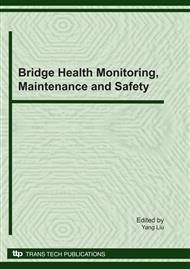p.1
p.13
p.23
p.37
p.51
p.67
p.77
p.89
Bridge Significant Failure Mode Identification Strategy under Traffic-Load
Abstract:
Increasing axle loads and traffic density made bridge accidents happened very often in China which caused the bridge safety assessment method in dire need. As a method for bridge safety assessment, the structural reliability analysis is widely accepted. An important part of system reliability estimation is to identify the subset of significant failure modes. In this paper, a stage critical strength branch and bound algorithm is proposed for the failure mode identification of bridge systems. The proposed method is implemented in the combination with the finite element package ANSYS and the MATLAB procedure, and is illustrated with the help of a truss bridge example. This algorithm is found efficient and reasonably accurate, and it can be applied to any kind of bridge systems without having to do much additional programming.
Info:
Periodical:
Pages:
13-22
Citation:
Online since:
December 2010
Authors:
Price:
Сopyright:
© 2011 Trans Tech Publications Ltd. All Rights Reserved
Share:
Citation:


